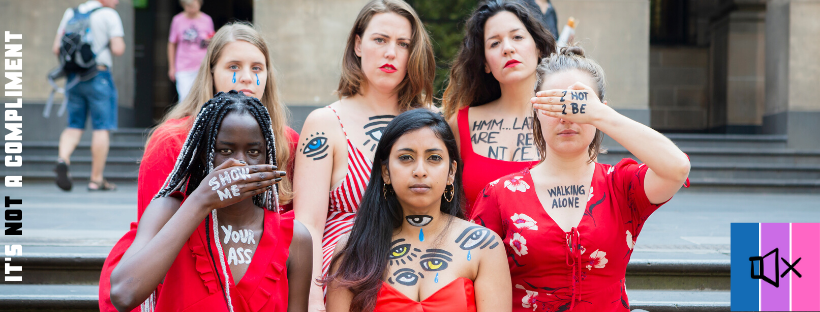it’s not a compliment: what we’ve learnt about street harassment in 2020
This year, our streets have been unusually empty.
We spent most of 2020 in some form or other of lockdown, only leaving the house when necessary. But even with pedestrian traffic dramatically reduced, street harassment hasn’t necessarily stopped or even slowed down. Rather, it has persisted, as harmful and as dehumanising as ever, and affected many communities — notably women of colour — in new and insidious ways.
As the year draws to a close, it bears reflecting on the kinds of street harassment we witnessed throughout. Although it’s sometimes taken on new forms, we’ve been able to learn a bit more about its essential nature, and the dynamics of power which underpin it. We’ve also learnt more about who its victims really are.
Street harassment doesn’t just affect (cis white) women
Before this year, we might’ve thought of street harassment as just unwanted glaring or catcalling directed at women. This isn’t untrue, and these practices are still harmful, but 2020 has shown us that other power dynamics are at play. In response to an ABC callout for example, many Asian Australians describe experiences of being ‘coughed on, bumped into and insulted in public places’ — what are these experiences if not street harassment?
The reality is that people at all intersections of marginalisation are vulnerable to street harassment in some form — not just people of colour even, but also people experiencing homelessness and disabled people. This diverse range of identities and their experiences with street harassment suggest that the problem is more complex than the popular, dichotomous narrative of man-catcalls-woman.
Street harassment doesn’t have to be in public spaces
Simone Kolysh argues that street harassment is nothing more than a way for perpetrators to exert power over their targets. She further highlights that street harassment cannot be separated from other forms of everyday violence such as bullying or discrimination because it’s the same power dynamics at play. This is exactly what we’ve seen this year: the people who are repeatedly harassed in public for being “different” are likely the same people who have already experienced discrimination in some form, and it is jarring to be constantly reminded that they don’t belong.
If we think of COVID-related racism within this context of a lifetime of being othered, we can see street harassment for what it truly is: just another way of reinforcing barriers in society and reminding people they need to think twice about existing freely, in public spaces or otherwise.
Everyone – including men – has a part to play in curbing street harassment
Although street harassment can happen to, and be perpetrated by, anyone, data has consistently shown that street harassment is overwhelmingly perpetuated by men towards women. This pattern holds true even when we consider all these other forms of street harassment. Women of colour experience it more than men of colour, for example, and only this year have those stories garnered national attention.
So where does that leave men in this equation? Are they simply perpetrators?
The answer to this question can’t be framed in a perpetrator—victim paradigm, where we only consider incidents of harassment in isolation. The answer is broader, and cultural. It goes back to masculine norms which can significantly limit the ability of men to develop traits like emotional intelligence and empathy, both of which are crucial to recognising just how harmful street harassment is. As a result, men who call out problematic behaviours like street harassment are often shunned by their peers. Jai Tao from the Men’s Project says, ‘Rigid ideas about what a man should and shouldn’t be can snowball into a collection of character traits that can have disastrous outcomes.’
On the flipside, men who do recognise street harassment for the harm it creates are better positioned to use their relative privilege and intervene when needed. Even if street harassment isn’t always man-catcalls-woman, it is usually men who enjoy more freedom and power. And they can leverage this to curb street harassment.
At the end of the day, ending street harassment is not about men versus women; it is about all of us versus the problem, no matter the form it takes.
So, what now?
As Melbourne emerges from months of lockdown and we start moving through public spaces again, it is perhaps worth remembering that street harassment will not stop unless we start pushing back against the power imbalances and societal norms that enable such behaviour. Some of us may have been fortunate enough to go months without experiencing any street harassment, but others have had to live through more harassment and in more ways than ever before.
As life returns to some semblance of pre-COVID normal, more allies in the fight against street harassment will see everyone afforded the right to exist freely in spaces across society.
Cheryl Tan is a community liaison and Mark Yin the media officer at It’s Not A Compliment, a Melbourne-based campaign fighting street harassment. The campaign runs Bystander Intervention Training workshops throughout the year in an effort to create awareness of street harassment and how to prevent it.


